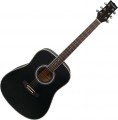Pickguard
A special protective pad that protects the soundboard from accidental contact with the pick.
The pickguard is usually located at the sound hole below the strings (if the guitar is considered in the standard playing position). With a dynamic, aggressive performance (especially when playing chords), it is in this place that the pick clamped in the hand most often hits; hitting an unprotected body causes damage to the surface of the body, which degrades the appearance and acoustic characteristics of the guitar. Pickguard prevents such damage: such an overlay is usually made of a hard material that is resistant to contact with most picks. Accordingly, the presence of this part is highly recommended if you plan to use the pick extensively when playing.
Note that the protective overlay usually differs in colour from the main material of the deck, due to which it is clearly visible.
Top deck
The material from which the top of the guitar is made is the flat part of the body on which the bridge (see below) and the sound hole are located.
A wide variety of materials are found in modern guitars — from
spruce, maple or
cedar, which are familiar in our latitudes, to expensive
mahogany and “exotics” like bubinga (“African rosewood”) or koa, which grows only in Hawaii. Each material has its own characteristics that affect the sound and other properties of the instrument (for example, appearance and durability). However, the sound of a guitar largely depends on a number of other factors besides the material — the type of instrument, the shape of the body, etc. Therefore, models made of similar materials may well sound noticeably different. In addition, note that expensive woods can be used solely for aesthetic purposes and have no advantages over cheaper materials.
In light of all this, we can say that the data on materials are more of a reference value, and when choosing, it is more likely to focus on more significant characteristics (for example, the same body shape), as well as practical data about the tool (reviews, reviews, audio recordings of the game etc.). Detailed data on materials may be required only by professional musicians, luthier masters, etc.; this information, if desired, can be found in special sources.
Bridge
The material from which the bridge (string holder) of the guitar is made is a device with which the strings are attached to the top deck.
Theoretically, the colour of the sound of an instrument depends on the characteristics of all its details. However, in the case of the bridge, this influence is so insignificant that the data on the material in this case are more of general reference and advertising than of real practical value. The variety of such materials is quite large; among the most common are
rosewood,
mongoy and
ebony.
Neck material
The material from which the neck of the guitar is made — more precisely, the base of the neck (the fretboard can be made from another material). Now the most commonly used materials are:
nato,
maple and
mahogany. For the value of this parameter, see p. "Top deck".

